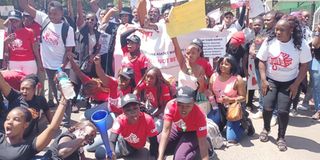Men say women not disadvantaged but they are wrong

Women lie on the road outside KICC during anti-femicide demos in Nairobi on January 27, 2024.
What you need to know:
- The world is not anywhere near bridging the gaps in women’s health, legal protection, leadership, and labour, among other aspects of development.
- In 2022, the United Nations estimated that it would take 286 years to close gender gaps in legal protection and remove discriminatory laws against women.
Lately, the men I have met during fieldwork in the slums, on the streets, in rural areas and some in formal employment have asked me questions that need answers.
Some have asked: “How can you say women are disadvantaged, yet everywhere you go NGOs (nongovernmental organisations) have empowerment centres for women?”
Others want to know why “the media keep saying women are disproportionately affected, yet they are getting jobs faster than men, and girls get pads, while boys are neglected.”
Scientists say the Earth has been in existence for about 4.54 billion years. In those years, no country has ever achieved gender equality: fair distribution of resources and opportunities resulting in equal enjoyment of economic, political and cultural rights.
Women continue to endure discrimination from all corners of their lives, gaps that global, regional and local agencies and ministries such as UN Women, African Union Commission's Women, Gender, and Youth Directorate, and the Ministry of Gender have sought to address.
Long walk to equality
But the world is not anywhere near bridging the gaps in women’s health, legal protection, leadership, and labour, among other aspects of development.
In 2022, the United Nations Department of Economic and Social Affairs and UN Women estimated that it would take 286 years to close gender gaps in legal protection and remove discriminatory laws against women.
And another 140 years to attain equal representation in positions of power and at least 40 years to achieve gender parity in national parliaments.
In 2023, the projections showed a worst case scenario linked to the steps the world took backwards in addressing these gaps at the height of Covid-19 (2020–22). That it would take 14 more years, which now means a journey of three centuries, to equal access to all human rights.
In a world where the life expectancy of a woman is 75.9 years and 73.3 years for a man as per the World Health Organisation, the data imply that only the 11th generation from now will enjoy the fruits of gender equality.
Evidence of inequalities
From the Global Gender Gap Report produced by the World Economic Forum (WEF) in 2022, women are lagging behind in every sector.
In economic participation and opportunity, 73 per cent of men were economically active compared to 62.90 per cent of women.
Last year, the Kenya National Bureau of Statistics (KNBS) released data showing that men spent only 54 minutes in unpaid care work daily, which includes cooking, washing clothes and taking care of the children, unlike the women’s four-and-a-half hours.
Time is a crucial factor in participation of women in work that earns them an income. In exclusion of income, poverty levels hit the roof.
In the 2021 Kenya Poverty Report by KNBS, women-headed households were found to have higher poverty rates of 38.8 per cent, far higher than the national average of poor rural households approximated to be 38 per cent.
The poverty rates for the Male-headed households were 32.7 per cent, though higher than the national average for the poor urban households set at 29.7 per cent.
In terms of political representation, WEF found Kenya had a mere 23.3 per cent inclusion of women in Parliament as the men took 76.7 per cent of the seats.
In education, women constituted 9.73 per cent of the students who had enrolled for tertiary education compared to 13.20 per cent of men.
Pregnancy largely contributes to girls dropping out of school, further reflecting on the number of girls who proceed to post-secondary education.
From the Kenya Demographic and Health Survey 2022, while the percentage of adolescents who have begun childbearing shrunk from 18.1 per cent in 2014 to 14.9 per cent in 2022, the decline isn’t uniform.
While the number of 16-, 18- and 19-year-olds-who had live births dropped, for those aged 15, the rates went up from 1.7 per cent in 2014 to 2.1 per cent in 2022. Under the education structure, a 15-year-old girl ought to be in Form One, and to many, a pregnancy means dropping out and early marriage.
However, men, too, are overburdened by particular challenges that ought to be addressed, especially drug abuse.
A 2022 report by the National Authority for the Campaign against Alcohol and Drug Abuse indicates that one in three men is using at least one drug or substance of abuse compared to one in every 16 women.
No competition
In an earlier interview, Africa for Equality Now regional coordinator Judy Gitau said the push for women and girls’ empowerment is not a competition.
“By removing the barriers that hinder girls from accessing their rights to education, and protection from child marriage or female genital mutilation, we are by no means creating barriers to men accessing their rights,” she explains.
“If men or boys feel like they are no longer accessing their rights, then, they should work towards the realisation of their rights. Rights are not like 10 balls in a bucket that if women get six, then men only have four to contend with.”





